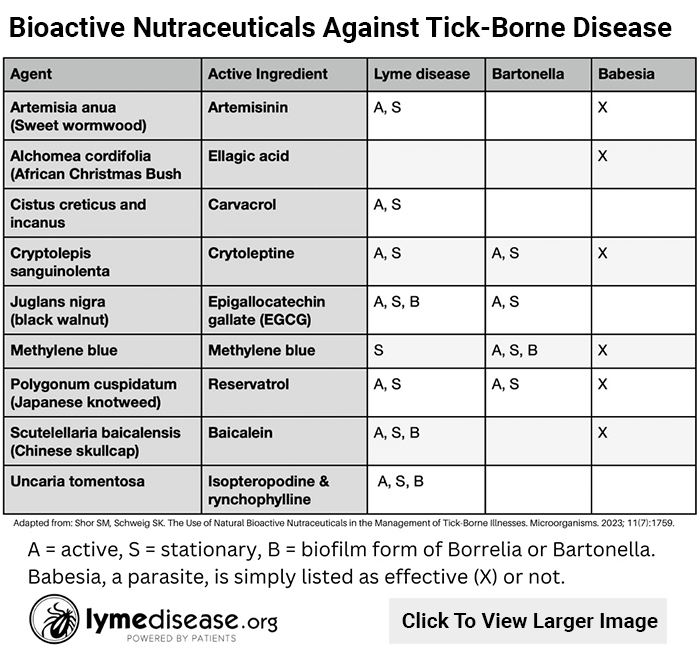Using herbs to treat Lyme disease, Bartonella, and Babesia

Humans have been using plants for medicinal purposes since ancient times. Today, botanical herbal medicine is increasingly being integrated with modern allopathic medicine.
Recently, two experts in complex chronic illness reviewed the literature on which botanical medicines are most effective against three common vector-borne diseases.
In their research, they reviewed over 400 academic articles that discussed herbal, botanical or nutraceutical treatment evidence against Borrelia, Bartonella and/or Babesia. (“Neutraceuticals” are therapeutic substances derived from foods.)
The paper entitled The Use of Natural Bioactive Nutraceuticals in the Management of Tick-Borne Illnesses was written by Samuel Shor, MD and Sunjya Schweig, MD and published in the journal MDPI: Microorganisms.
Importantly, the authors note whether these botanical medicines are active against the growing, stationary, and/or biofilm forms of the pathogens. In all, they list over 30 natural substances with efficacy against Borrelia, Bartonella and/or Babesia.
“One of the most groundbreaking findings of our previous research, in collaboration with Johns Hopkins, was that Cryptolepis sanguinolenta has in vitro activity against Borrelia and Bartonella, in addition to Babesia,” said the paper’s co-author Sunjya K. Schweig, MD, President and Director, California Center for Functional Medicine. (“In vitro” means in a test tube, compared to “in vivo,” which means in a living organism.)
When pathogens change form
Most antibiotics, including doxycycline, attack the growing form of the pathogen. However, many microorganisms, like Borrelia, will change form when threatened by antibiotics. They can transform into a slow-growing or dormant state which is more resistant to antibiotics. In addition, biofilms are notorious for causing treatment-resistant forms of infection.
Tick-borne diseases are typically treated with a limited number of medications prescribed by a healthcare provider. Doxycycline, the standard antibiotic used for Lyme disease, often fails to cure the illness, leaving 10-30% of patients who receive prompt treatment with residual symptoms. Left untreated or undertreated, the disease can progress to a chronic infection, making it even more difficult to cure.
There are many theories about the reasons for treatment failure in Lyme disease including: genetics, persistent infection, immune evasion, autoimmunity or immune dysregulation and physical damage to the systems of the body.
Regardless of the reason for persistent symptoms, the fact is patients simply want to get better. While evidence has shown that extended combination antibiotic treatment can be effective, not everyone has access to or can afford it. As a result, many patients may explore complementary and alternative approaches, including the use of botanical medicines and nutraceuticals.
In this age of growing antibiotic resistance, many healthcare professionals try to limit their use of antibiotics. To aid in healing, and even to boost the efficacy of antibiotics, many clinicians have learned to use botanical medicines.
Botanical medicines
“We use many botanical medicine protocols for Lyme and other tick-borne diseases but also for gut issues, adrenal and hormone issues, inflammation, cardiovascular diseases, health optimization and longevity, and so much more,” said Dr. Schweig. “These can be used as standalone protocols or layered/combined with prescription medications as needed and appropriate.”
Over the past three years, researchers including Dr. Schweig have published studies showing herbal medicines that kill these common pathogens in the laboratory including:
- Seven herbal medicines can kill Lyme disease bacteria in a test tube.
- Five herbal medicines show potency against Bartonella in test tube.
- Five herbal medicines potent against Babesia duncani in test tube.
Here is a short list of the above-mentioned botanicals, showing which bacteria they are effective against, as well as if they hit the active (A), stationary (S) or biofilm (B) form of Borrelia or Bartonella. For Babesia, a parasite, the list simply indicates whether the substance is effective (X) or not.
For a full list of all 30+ bioactive nutraceuticals, see Appendix A. Summary of Clinical Impact.
Of note, four of the above—Cryptolepis, black walnut, Japanese knotweed, and Chinese skullcap—were shown to be more effective in a test tube against Borrelia burgdorferi than commonly prescribed antibiotics.
Hope for the future
Dr. Schweig says, “It is my hope and belief that botanical medicines will continue to help people recover from multiple chronic illnesses, including tick-borne diseases, improve treatment outcomes, decrease side effects of treatment, and prevent relapse. With more research, including animal studies and eventual human studies, I hope that we will continue to discover optimal protocols.”
It is crucial to note that while some studies have shown promising results in vitro or in animal models, human clinical trials for botanical treatments in Lyme and tick-borne diseases are still needed.
As always, consult with a healthcare professional before trying any alternative treatments or supplements, as they may interact with other medications or medical conditions.
LymeSci is written by Lonnie Marcum, a Licensed Physical Therapist and mother of a daughter with Lyme. She served two terms on a subcommittee of the federal Tick-Borne Disease Working Group. Follow her on Twitter: @LonnieRhea Email her at: lmarcum@lymedisease.org.
Reference
Shor SM, Schweig SK. The Use of Natural Bioactive Nutraceuticals in the Management of Tick-Borne Illnesses. Microorganisms. 2023; 11(7):1759. https://doi.org/10.3390/microorganisms11071759
Resources
What alternative treatments work for Lyme disease? What are their side effects?
Natural remedies for the chronic inflammation of Lyme disease.





















We invite you to comment on our Facebook page.
Visit LymeDisease.org Facebook Page